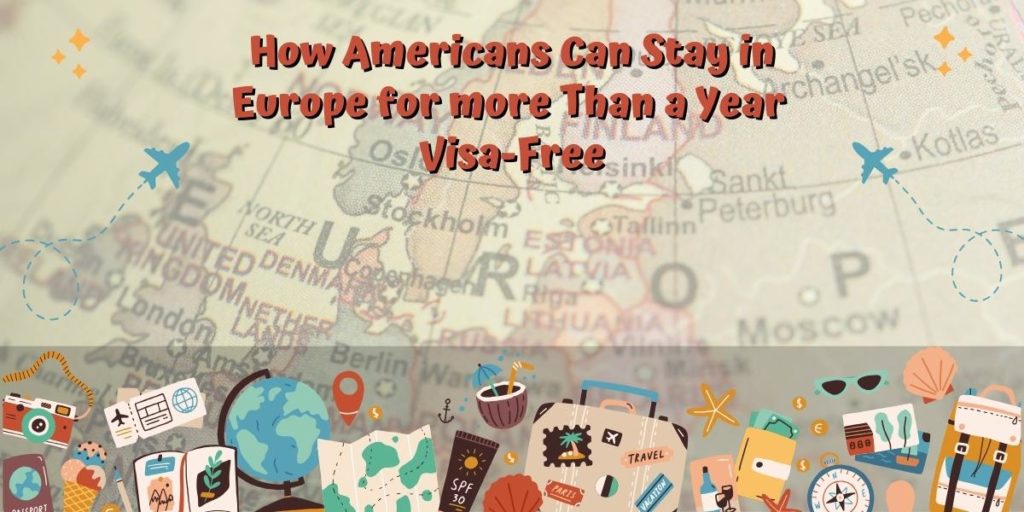How Americans Can Stay in Europe for More Than a Year Visa-Free

How Americans Can Stay In Europe For More Than A Year Visa-Free
Europe has consistently been a popular choice for American travelers. It’s logical since, within a compact area, you can encounter a wealth of history, diverse cultures, and stunning landscapes.
But what if you want to stay longer than the typical vacation and extend travel? How can an American stay in Europe for longer than the 90 days the Schengen area states?
In this article, we’ll explain more about bilateral agreements and what it means for Americans practically.
We’ll also check out the best routes that help you make the most of this chance if you’re using CarTurf’s service to travel around Europe by car.
Make the Most of Visa-Free Exploration
The Schengen Area has 26 European countries. It grants US citizens the privilege of visa-free stays for a maximum of 90 days within a 180-day timeframe.
Nonetheless, European countries offer extended visa-free travel opportunities. This allows for more extended and immersive experiences.
Limited Exceptions
While many European countries offer visa-free travel, there are limited exceptions. For the latest information on entry requirements for each country, visit the US Department of State’s website.
Use the Electronic System for Travel Authorization
If you plan to enter the Schengen Area, ensure you have an approved ESTA, which is essential for entry. Apply for ESTA through the official US Customs and Border Protection website.
- Travel Insurance:
Consider purchasing travel insurance with comprehensive coverage for medical treatment and trip interruption. This will provide peace of mind during your extended stay in Europe.
- Train Travel:
Explore Europe via its extensive and efficient train network. It’s a scenic way to travel and can save you money compared to flights.
- Secure Your Return Flight:
To follow immigration laws and ensure a smooth departure, have a confirmed return flight within your visa-free stay period.
- Research Bilateral Trade Agreements:
Some countries have bilateral trade agreements with the US that can influence visa-free travel policies. Stay informed about any updates related to these agreements.
- Visit the US Embassy:
If you encounter any issues or need assistance during your stay, don’t hesitate to contact the US Embassy in the respective European country. They can provide guidance on a range of matters, including social security concerns.
- Department of Homeland Security:
Stay informed about any updates or changes in US Department of Homeland Security r regulations that may affect your travel plans.
- Travel Bank and Travel Credits:
Consider using travel bank accounts or accumulating travel credits to help finance your extended stay in Europe.
Understanding the Basics & the Math of Bilateral Agreements + the Schengen Zone
Picture this: 27 European countries where you can cross borders without flashing your passport every time. Although there are border posts every now and again, you don’t usually have to stop the car.
Now, while Americans usually get a 90-day pass to roam these countries visa-free (within a 180-day period), there’s a very useful exception!
- Belgium (3 months)
- Denmark (3 months)
- Italy (3 months)
- Hungary (90 days)
- Portugal (60 days)
- Spain (90 days)
- France (90 days)
- Latvia (90 days in half a year)
- The Netherlands (90 days)
In the special deals, you have to stay in one EU country, and you can’t go wherever you want in the Schengen area. You can see the above list on the ETIAS website.
With some smart planning, an American could explore Europe for up to 2 years and four months without stepping out of the Schengen area. Talk about an extended vacation!
Enhanced European Road Trips
Traveling by car not only grants you the liberty to set your own pace but also offers a distinctive perspective on the continent.
But road trips through all countries with bilateral agreements with the USA are not viable.
Denmark, Hungary, and Latvia, for instance, do not share borders with the other countries listed.
Outlined below are some suggested routes for those seeking to prolong their European sojourn through car travel:
- Route 1:
Schengen Zone (90 days) – Commence in a non-listed Schengen country. Belgium (90 days) – Enter directly from the Schengen Zone. France (90 days) – Head south from Belgium. Spain (90 days) – Drive south or west from France. Portugal (60 days) – Extend your journey westward from Spain.
- Route 2:
Schengen Zone (90 days) – Start in a non-listed Schengen country. The Netherlands (90 days) – Enter directly from the Schengen Zone. Belgium (3 months) – South of the Netherlands. France (90 days) – South of Belgium. Spain or Italy (90 days) – Venture south or east from France.
- Route 3:
Schengen Zone (90 days) – Commence in a non-listed Schengen country. Italy (3 months) – Enter directly from the Schengen Zone. France (90 days) – Travel west from Italy. Spain (90 days) – Continue west from southern France. Portugal (60 days) – Extend your journey westward from Spain.
- Route 4:
Schengen Zone (90 days) – Begin in a non-listed Schengen country. Italy (3 months) – Enter directly from the Schengen Zone. France (90 days) – Travel west from Italy. Belgium (90 days) – Continue north from southern France. The Netherlands (90 days) – Proceed north from Belgium.
Staying in Non-Schengen Countries Resets your Schengen Clock
When we talk about traveling to Europe, we often refer to Western Europe, which is mostly made up of Schengen countries. However, there are European countries that are not part of the Schengen Zone.
See the list of non-Schengen countries below:
- The UK
- Republic of Ireland
- Bulgaria
- Romania
- Serbia
- Montenegro
- Bosnia and Herzegovina
- Turkey
- Cyprus
- Belarus
- Azerbaijan
- Albania
- North Macedonia
Tips for a Smooth Journey
- Plan Ahead:
Make sure you know the visa-free periods for each country in advance.
- Stay Informed:
Check the latest visa and entry requirements on official websites before making any travel plans.
- Document Your Stay:
Since Schengen countries have open borders, you won’t receive a passport stamp when entering a new country. It’s similar to traveling between US states. While this is convenient, the downside is that you need to provide evidence that you stayed the correct number of days in a specific country.
- Consider Seasonal Factors:
Europe’s climate varies significantly. Northern countries can be really cold in winter, while southern countries can get extremely hot in summer. Plan your itinerary accordingly.
- Toll Roads & Driving Conditions:
Some countries, like France and Italy, have toll roads. Make sure you’re ready for these expenses and get to know the local driving conditions and rules.
Conclusion
Ready to explore the wonders of Europe? From the sun-soaked beaches of Spain to the historic charm of Hungary, there’s so much to see and do.
And here’s some good news for Americans: thanks to special bilateral agreements, you can have more than 90 days. With the correct planning, you can enjoy Europe for over a year visa-free!
Take your time, plan your route, and immerse yourself in the rich tapestry of cultures. Whether you love history, food, or travel, Europe has something unique for everyone.
And a tip from us at CarTurf: consider exploring Europe by road for an even more enriching experience. Safe travels, and enjoy the journey!






